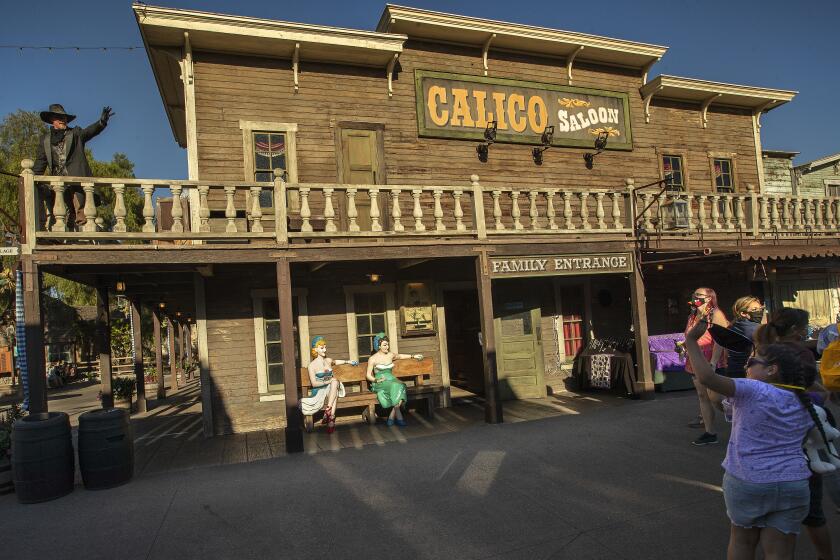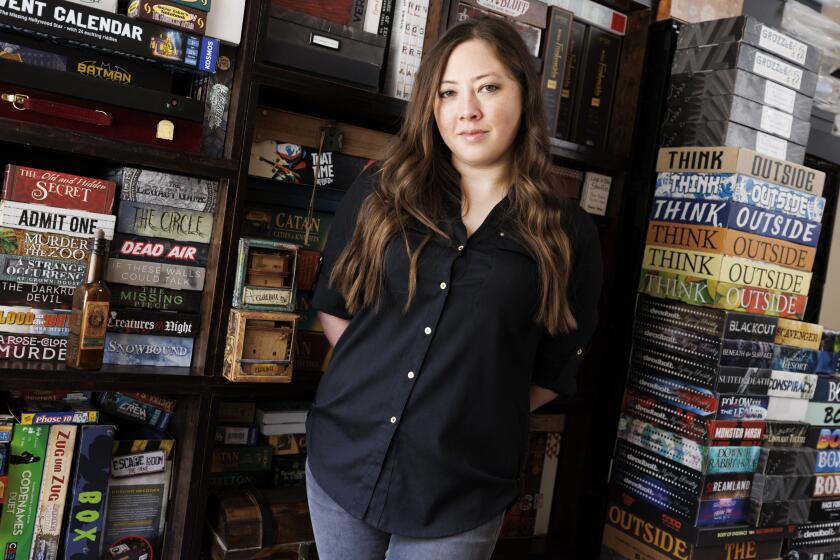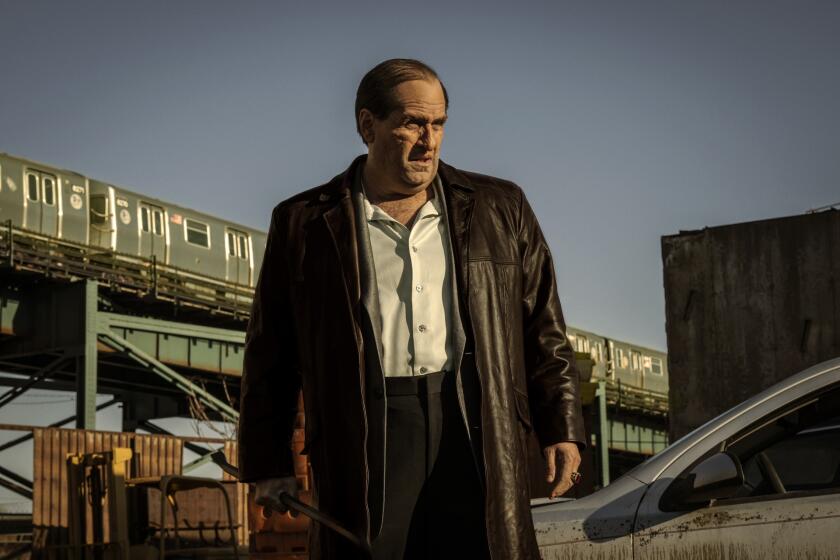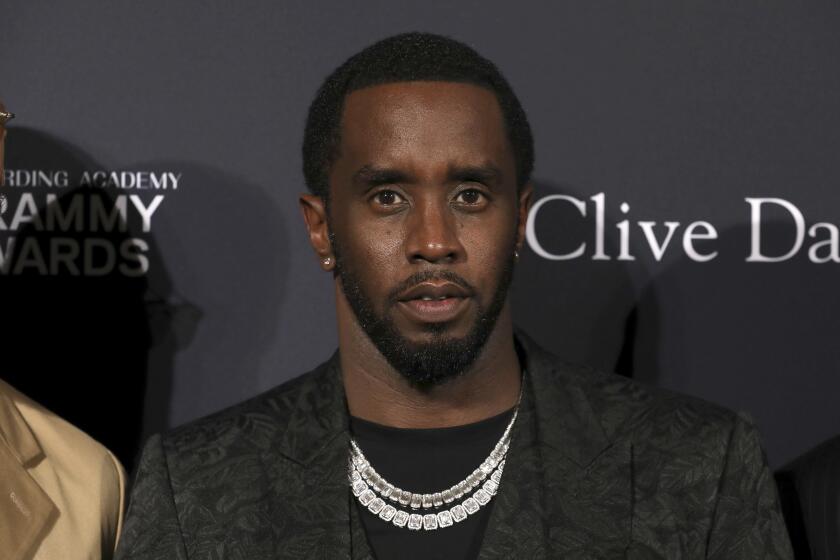This was supposed to be the year that Meow Wolf, creator of interactive experiences, became so integral to popular culture that, in the words of one of its filings with the Securities and Exchange Commission, it would be well on its way to becoming a “provider of themed entertainment and creative experiences on the level that people think of Disney, Universal and Marvel.”
And on March 8, as I spent a Sunday afternoon in the company’s Santa Fe, N.M., exhibition space, that boast didn’t seem so far-fetched.
Crouching down in one of Meow Wolf’s byzantine rooms I entered what appeared to a doorway and found myself in the back seat of a van-like contraption that seemed to have been willed into existence by the creator of some long lost TV show. The handles and knobs appeared to have been lifted from a black-and-white sci-fi serial and the steering wheel, inaccessible to any human without a ladder, sat motionless even as I watched a horizon rush by through a windshield that stood perpendicular to the ground.
To sit in this strange vehicle was to essentially lie back, and lie back I did, probably for a good 20 minutes, looking out beyond the dashboard onto a screen that aimed to mimic the sensation of gliding through a supernova. The effect wasn’t fancy — a naysayer could write it off as a glorified screensaver — but Meow Wolf’s House of Eternal Return isn’t throwing down a high-art gauntlet so much as it is extending an invitation.
Meow Wolf’s theater-like set seeks to envelope us as if in a fairy tale, using modern life not as a cause to escape but as a jumping-off point. Leaving the vehicle, I began exploring, traversing wooden and fiberglass structures that were neon forests and intergalactic travel agencies, eventually settling into a trailer in what seemed like a backyard campground.
A family soon joined me. “Are you waiting for the fortune teller?” one of them asked. Curious, I decided to linger. “Will you let us know if she shows up?” the woman asked. I agreed to the request, although I knew finding this family would likely be impossible amid glowing prehistoric bones, TV-laden corridors and even a Chinatown-inspired district. Still, past encounters that can become future run-ins seemed entirely plausible in this dream factory.
Alas, the fortune teller never arrived. No matter. The future we were about to enter — when COVID-19 pandemic fears would soon grip the nation — wasn’t fit for simple predictions.
In the coming days, the NBA, MLB and cultural institutions such as Disneyland would be forced to deal with the realities of COVID-19. Meow Wolf too would see its plans derailed. By the end of the week, House of Eternal Return, Meow Wolf’s indoor playground for adults and families, would close — and as of this writing, the touch-heavy attraction remains shuttered. So far, the company has laid off or furloughed more than 200 of its staff, a cut that amounts to about 56% of Meow Wolf’s workforce.
More damning, the pandemic has delayed the expansion of Meow Wolf properties planned for Denver, Phoenix and Washington, D.C., the latter two of which the company now says are “still actively being considered,” but had no updates on timing. Up first, however, is an ambitious 52,000-square-foot multistory exhibit just a few minutes from the Las Vegas Strip that was supposed to open this year. Given that its Santa Fe outpost draws about 500,000 visitors per year, Meow Wolf’s growth was set to remake immersive entertainment into a new kind of theme park with the argument that art and design — and not intellectual property — is what draws an audience.
The coronavirus era offers opportunities to reimagine experiences. It’s time to start thinking of the entire park as an attraction.
Meow Wolf is a leader in the emerging world of themed, environmental storytelling that places an emphasis on the active participation of guests — in other words, play — and its work bridges the underground and the mainstream, posing fresh questions on how we experience everything from gallery spaces to theme parks to immersive theater.
Battered but not beaten, Meow Wolf, which received a Paycheck Protection Program loan for $5 million to $10 million, still has a pulse. Work continues on its Las Vegas project, which will bring Meow Wolf closer to Los Angeles via a retail and entertainment facility dubbed Area15. Meow Wolf is the anchor tenant — Los Angeles distillery Lost Spirits, which bridges fantasy and rum, is another intended occupant — and while Meow Wolf now doesn’t plan to open there until early 2021, provided the pandemic cooperates, of course, Area15 will begin a soft launch this fall that will allow visitors to see what Meow Wolf has planned.
What they will see is Meow Wolf’s most ambitious, risk-taking and suddenly brazenly topical endeavor yet: the grocery store-inspired Omega Mart.
It’s a concept Meow Wolf has toyed with in the past, but not on this supermarket-size scale, and certainly not during a pandemic, when the very idea of a grocery store has taken on significantly more weight. Like the suburban home that opens the House of Eternal Return, where a path through a fridge leads to otherworldly, black-lighted forests, the Omega Mart will prod guests into fantastical areas — think worlds inspired by the Painted Desert, as one potential example — only with more overt themes tackling American consumerism and corporate responsibility.
Creating a walk-through experience that felt more of the moment was a Meow Wolf goal, even if it’s one with mops that morph into snake-like creatures that ooze radioactive colors (also be wary beyond the mart of robots with computer monitor-like heads, as they appear to have some questionable intentions).
Sitting in his Santa Fe office in early March, Meow Wolf’s cofounder, Corvas Brinkerhoff, executive creative director of the Las Vegas space, was keen to talk about the grand vision for Las Vegas, which includes everything from cards equipped with radio-frequency identification (RFID) technology to a deeper embrace of game-inspired, exploratory techniques.
“There is a very central environmental stewardship and corporate stewardship theme in the show,” Brinkerhoff said. “What is the responsibility of these huge corporations to all of us, to the planet? We’re talking about that in a big way. And there’s a theme of resistance, of empowerment, of people on the outside that are saying, ‘Hey, we need to fix all of this.’ They’re taking things into their own hands and resisting the impact of these corporations. You start with satire, and then you go deeper.”
Such themes, especially those topics of rebellion, have taken on a greater role since that March interview, as the pandemic has been joined by ongoing nationwide protests and a general cultural reassessment. Grocery stores have been remade into places of tension in how we shop, what we shop for and how we compensate the recently recognized essential workers who make up their workforces. As Meow Wolf’s cofounder and Omega Mart architect, Emily Montoya, said last week, now more than ever we are confronted with every purchase choice, cleaning and inspecting anything we bring into our homes, and questioning the political leanings of the corporations we support.
The Omega Mart is a reflection of Montoya’s absurdist-meets-whimsical sense of humor. Staff, in a shift for Meow Wolf, will be in character, and the space will intermingle purchasable products with art installations.
Take home, perhaps, a box of Corn of Plenty, a nonedible “forever cereal” made of plastic bits. The box will contain lots of lawyer-mandated warnings, as well as the acknowledgement that should you eat the plastic, “it will likely pass somewhat uneventfully through your digestive system, like an estimated 5 grams of plastic already does” on a weekly basis. While the Omega Mart is just the entry to multiple areas filled with floor-to-ceiling art, such text is indicative of the method behind Meow Wolf’s madness.
It also shows that as Meow Wolf grows — Denver is the company’s post-Las Vegas destination — and becomes more explicit in declaring itself fantastical, family entertainment, it’s also trying to retain some of its rebellious, question-the-world attitude. The company’s goals are clear. “It’s themed entertainment,” said Spencer Olsen, art director of Meow Wolf Las Vegas. And yet, he adds, “internally, the creative team refers to it as an art exhibit.”
As COVID-19 rages in Florida and California, what does it mean that Disney World is open while Disneyland remains closed even for its 65th birthday?
Such a statement is only contradictory to those who gatekeep, playing into long-held cultural assumptions that the wonder that surrounds and comforts us — the wildly colorful designs of Meow Wolf or the exquisite narratives of Disneyland’s New Orleans Square — are somehow lesser for appealing first to emotional rather than intellectual impulses.
Meow Wolf may not erase those boundaries or change the mind of a skeptic, but consider it an unspoken long-term goal.
“What we’re doing is a social experiment,” Montoya said. “It’s our responsibility as artists to respond to the world that we’re living in. I think more and more, we can’t sit back and fall into escapism. We have to find a way to ask questions about the world that we’re living in as we continue to blur the line between reality and unreality. It’s an ongoing, very experimental thing. It’s not about being so afraid to fail and being so afraid to say something that you end up not saying anything.”

Scrappy origins
Meow Wolf’s beginnings have been told so often that the company even has its own self-serving, myth-shaping film to serve as an explainer. The 2018 “Meow Wolf: Origin Story” documents, with bias, the company’s rise from a scrappy, punk rock-like art collective in 2008 to an “experience economy” corporation that in one round of funding, according to an SEC report filed in May 2019, had raised $158 million. On its board is Winston Fisher, part of the New York-based real estate developer family that runs the firm Fisher Brothers. He is also the developer of the Las Vegas Area15 project.
Certainly, the pandemic is stressing Meow Wolf’s founders. Asked what will happen if the Las Vegas locale and Meow Wolf’s Santa Fe space cannot open until well into next year, Brinkerhoff said, “I don’t know what business can survive if this shutdown goes on for a year or two.” Run that sentiment by Fisher, and the grimace was apparent even on Zoom, as he noted that Meow Wolf “is in a position to survive. That doesn’t mean you don’t feel this financially, but they’re positioned to survive through this.”
Meow Wolf has long defied doubters and exceeded expectations, even growing at a pace its founders couldn’t always maintain. While the lack of a formal business structure could be part of Meow Wolf’s charm — the aforementioned fortune teller I was told about in Santa Fe is a local resident, who, while on the payroll, sets her own schedule and is not a Meow Wolf character — the company’s laissez faire early approach has led to some labor-related legal entanglements that more standard business formalities probably could have avoided. Last year, the company’s cofounder, Vince Kadlubek, stepped aside to make way for a three-pronged chief executive team that includes Disney, Lucasfilm and financial veterans.
Now the stuff of oft-cited Meow Wolf legend, its first full year of operations in 2017 brought close to half a million visitors to the House of Eternal Return. The space, constructed famously in an abandoned bowling alley after a $3-million investment from Santa Fe local and “Game of Thrones” author George R.R. Martin, builds on the group’s penchant for explorable art. Earlier projects were, for outsiders paying close attention, presenting an alternate, contemporary art world take on modern, theme park-like environments, though this wasn’t Meow Wolf’s specified design intent.
See the 73-foot ramshackle sea-faring vessel that was the Due Return, only instead of Disneyland’s romanticized Sailing Ship Columbia history, there were alien, spacey environments filled with colorful fungi. Or Glitteropolis, an exhibit that’s as sparkly as it sounds, with random objects transformed into miniature villages as pleasing to the eye as It’s a Small World.
Thus, it was no great leap that the House of Eternal Return would be celebrated alongside Shanghai Disneyland with an award in 2017 by the Themed Entertainment Assn., although Brinkerhoff said he believed the initial emails from the industry group were spam. Lessons from the industry have helped define Meow Wolf’s way forward, and not just because a robot animatronic is destined for the Las Vegas exhibit.
“The greatest depth of an experience we can create is an emotional one, and that’s story,” Brinkerhoff said. “That’s how we connect with each other as human beings. So we want to use that. Las Vegas is a generational leap from what you see here in Santa Fe, in terms of storytelling. It’s richer, more dense and more complex. The ways that the story unfolds is through this dense web of narrative vehicles.”
The pulpy sci-fi narrative of the House of Eternal Return, dealing with the mysterious disappearance of a family and the arrival of portals that lead to dreamlike dimensions, is largely contained in the two-story home itself. In Las Vegas, the Omega Mart will be a jumping-off point to a tale that’s spread throughout the venue. Once inside, you may hear of shoppers who have disappeared, or simply spend your time perusing the more than 100 products Meow Wolf is creating for the store.
Some will be interactive, such as a display of Camel’s Sop cans that can shape-shift, and others will be grotesque, such as carved meat sculptures. The aesthetic will be bright, colorful and full of distractions, with influences ranging from 99 Cents Only Stores, Andy Warhol, childhood cartoons and some retro monster movie aesthetics, as the fresh seafood is a crustacean-meets-mollusk mash-up. You’ll be invited to play, as a stay-at-home camping log, the Tubular Fire Boomstick, will boast nature simulation effects.
There’s plenty of silliness, such as vitamin supplements for office drones (Sit Longer, Blink Less), as well as a janitorial closet that isn’t what it seems. Pre-pandemic, Montoya spoke of the grocery store as possessing just the right amount of absurdity and mundanity. “You are confronted with this cacophony of voices that are telling you to do things. ‘Don’t buy this. Buy this.’ There’s this weird freedom of choice that’s inviting you to redefine your identity based on what you buy. This one says organic, but this one says organic non-GMO, but that one is cheaper, but am I just paying for a brand? Then you’re missing the bigger picture — someone is walking into a portal right behind you.”
Both Brinkerhoff and Montoya describe the Las Vegas space as something akin to an open-world video game, although there is never a clear end. Brinkerhoff envisions 15-step puzzles that will lead visitors on escape room-like scavenger hunts through the entire venue, as well as an internal phone system with numbers that are hidden or must be decoded. But the Omega Mart section alone, complete with a pharmacy (Read: Booze), a floral section and mirage-like effects, not to mention surreal products, should provide a day’s worth of content, from custom-made art by Las Vegas locals to fake-but-not-fake merchandise you can bring home.
“We’re trying to create the sense that you are an avatar, like your physical body,” said Brinkerhoff, adding that guests to Omega Mart will be given an RFID card that declares them employees of the store. While the hope is that the latter can be used for environmental interactions, Meow Wolf wants visitors to view themselves as players, and thus is assigning them roles.
“That’s what’s exciting for me,” Brinkerhoff added, “to borrow ideas from video games, but give people the experience in their bodies.”
Long-term, Jim Ward, one of Meow Wolf’s three chief executives, along with Ali Rubinstein and Carl Christensen, talks of an accompanying app, one that can turn Meow Wolf’s physical spaces, as well as our homes, into a giant alternate reality game that continually feeds the Meow Wolf universe. An app is also planned as a solution for transforming some of Meow Wolf’s high-touch exhibits into socially distant experiences.
Sit back and enjoy the ride? No more. From Disney’s new Star Wars: Rise of the Resistance to Japan’s upcoming “living video game” Super Nintendo World, theme-park audiences must participate to get the full experience.
Meow Wolf’s bigger, more established competitors have also been embracing the app game model. Universal’s vision for Nintendo in its theme parks is to create a giant play space, and Disneyland’s Galaxy’s Edge was envisioned as a platform, one embellished with a mobile video game, in-character staff and rides that nod to immersive theater and video games.
If there’s one simple difference, however, Meow Wolf’s narratives constantly raise questions. “Being in a kind of a game, the whole idea is discovery,” said Montoya, noting that Meow Wolf is content for its exhibits to not answer any questions. The open-ended nature of Meow Wolf is its appeal.
“You’re right in that the big corporations — the Disneys and the Universals of the world — are shifting,” said Rubinstein, who came to Meow Wolf after two decades at Walt Disney Imagineering.
“Galaxy’s Edge is an example of that, but I do not believe those companies are looking at any land or attraction they design in a way that can be experienced entirely differently by any guest. There is always a narrative through-line. Even though they may have multiple access points and multiple experience in a given land, there is still predictability. There is a planned narrative and a planned experience that a guest will have. There is very little predictability in a Meow Wolf exhibition.”
And yet what inspired me to linger so long in the House of Eternal Return wasn’t to crack the code of some of its puzzles or even to take in all its art. For as outlandish as people describe Meow Wolf, it never felt less than comforting.
When we discover the writings of the fictional family that is said to have disappeared from the house, we encounter drama, fears and insecurities that mirror our own. But in this setting, the twinkling, goofy-weird exhibits of Meow Wolf read as a celebration of flaws, a world of wonder that tells us weirdness is not only OK but also vital.
For all the talk of consumerism and corporate responsibility in its upcoming art, it’s worth noting that Meow Wolf isn’t compared to the likes of Disney just because it’s making themed entertainment. It’s home to a bunch of optimistic fools.
“I really hope that this can be a source of hope for people, that this can give people something to look forward to,” Brinkerhoff said a few weeks into the pandemic. “This isn’t forever. There’s still beautiful, amazing, bizarre, psychedelic and otherworldly things happening. I think we’re in this interesting moment where it feels like time has stopped, and it’s helpful to have something on the horizon.
“This is a dark moment,” he adds, “but we will get through this.”
More to Read
The biggest entertainment stories
Get our big stories about Hollywood, film, television, music, arts, culture and more right in your inbox as soon as they publish.
You may occasionally receive promotional content from the Los Angeles Times.













